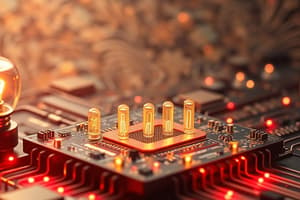Podcast
Questions and Answers
Define the three types of materials based on their conductivity and give examples of each.
Define the three types of materials based on their conductivity and give examples of each.
The three types of materials based on their conductivity are conductors, semiconductors, and insulators. Conductors are materials that allow the flow of electric current easily, such as metals. Semiconductors have moderate conductivity, such as silicon and germanium. Insulators are materials that do not allow the flow of electric current easily, such as rubber and wood.
What is the difference between a conductor and an insulator?
What is the difference between a conductor and an insulator?
The main difference between a conductor and an insulator is their ability to allow the flow of electric current. Conductors are materials that have high conductivity and allow electric current to flow easily. Insulators, on the other hand, have low conductivity and do not allow electric current to flow easily.
What are the basic logic gates used to realize logical expressions?
What are the basic logic gates used to realize logical expressions?
The basic logic gates used to realize logical expressions are AND, OR, and NOT gates. These gates can be combined to create more complex logic circuits.
What are the Sum of Product (SOP) and Product of Sum (POS) forms in combinational logic design?
What are the Sum of Product (SOP) and Product of Sum (POS) forms in combinational logic design?
What is a Karnaugh Map (K-Map) and how is it used in logical function representation?
What is a Karnaugh Map (K-Map) and how is it used in logical function representation?
What are the main types of power devices used in electrical engineering and what are their switching characteristics?
What are the main types of power devices used in electrical engineering and what are their switching characteristics?
What are the two types of power converters and how do they differ?
What are the two types of power converters and how do they differ?
What is the purpose of a linear voltage regulator and how does it work?
What is the purpose of a linear voltage regulator and how does it work?
What is FPGA and how is it used in electrical engineering?
What is FPGA and how is it used in electrical engineering?
What are the steps involved in the realization of logical expressions using basic logic gates?
What are the steps involved in the realization of logical expressions using basic logic gates?
Flashcards are hidden until you start studying




